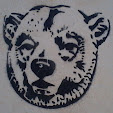One of the more unusual things in my possession is this old kit bag, about twice the size of the one I was issued with in '84, but half the strength of material, being quite soft, compared to mine which is like a canvas belt material, only bags bigger!
The base is heavier though, to prevent wear on trains, mud-tracks and ferries! It's brown, I don't know if there's a colour code, but I think the Navy have always been white, ours were standard 'army green' and the RAF had theirs in the same blue as their best dress, so there maybe/may have been a code, with women's' forces or reserves in brown?
It's marked MK DALY - QAIMNSR - BEF, which is the name of the owner, the unit (Queen Alexandra's Imperial Military Nursing Service Reserve), these days you tend to put the 'R' in brackets, but back then they clearly didn't! And British Expeditionary Force, our troops in France.
A little non-arduous Googling quickly revealed some of her history, she seems to have served from at least 1916 sometime (one of some 10,000 women), probably earlier, with a war diary in the National Archive revealing;
"Recommendation for 1 months’ sick leave for Miss M. K. Daly, QAIMNSR, 1 General Hospital, suffering from neurasthenia."
A euphemism for what we later called shell-shock (see below), and now call PTSD (Post Traumatic Stress Disorder), from Abbeville (the Somme) on the 15th October 1916, suggesting she had already seen more than most of our generation ever will, and most of it pretty bad.
However, they were made of sterner stock in Edwardian Britain, and the same diary's entry (I couldn't ascertain the name or sex of the author) for 15th June 1917 reveals;
"To Frevent (Frévent, about 18km NE of Abbeville, ed.), to 6 Stationary Hospital, arriving at 12.15 noon. Went round the hospital with Miss Daly, the A/Matron, and the CO, Lt. Col. Harding. All in excellent order – had been evacuating largely – about 350 cases in hospital at the time of the visit. Saw the new hut for officers suffering from shell shock – not yet in use, to be opened next week, which will greatly relieve the existing Officers’ Hospital, which was overcrowded on the day of my visit, owing to a large number of shell shock cases. 59 officers in hospital altogether. Had lunch in the Sisters’ Mess, most comfortable and well kept."
So, she had returned to work, and was helping officers recover from what she had herself suffered from a year earlier.
The third mention of her I could find was her gazetting in the King's birthday honours list for 1919, where the British Journal of Nursing reports on January 25th;
"The King has been pleased to award the Royal Red Cross, second class, to the following ladies in recognition of their valuable services : — . . . Miss M. K. Daly, Staff Nurse, Q.A.I. M. N. S. R. . . . "
At no point was her Christian-name or middle-name revealed, there were at least two other Daly's, one seems to have spent her war in the hospitals at Colchester, the other gets a brief mention in Scotland (I think, it was 'in passing'?), and one wonders what happened to her, all three of them, or indeed, the many thousands who 'answered the call', after the war?





2 comments:
Very nice find. A bloody war it was; WWI. I was just watching Glory. It seems impossible that someone would order one's own soldiers to expose oneself to blistering fire. WWI wasn't too much different than the way the ACW was fought.
I was always taught the ACW was the first modern war Jan, trenches, barbed wire, telegraph, railways, ironclads, balloons . . . then the Franco-Prussian war, which we don't get so much on, but Paris was sieged by trenches.
H
Post a Comment